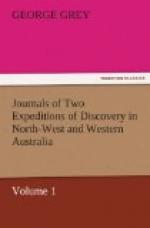At 8 hours 40 minutes P.M. the colonial brig Mary arrived, bringing along with her a native of India, whom she picked up on one of Flinders Islands.
On the 18th July the Lascar came on board the Success, and from him I learned the following particulars: That he belonged to the ship Fame, which was wrecked in the Straits; that he and a few others escaped in a leaky boat after rowing for forty-eight hours. On landing the natives stripped them of their clothes, etc., but otherwise behaved very kindly to them. His companions in misfortune died the first year of his residence amongst the natives, which in all amounted, he said, to six or seven years.
The men in that part of Australia have from five to ten wives, of whom they are rather jealous at times. The tribes are continually at war with one another, and have regular pitched battles; but the moment that one is killed on either side, the battle ceases, until they carry off their dead, and mourn for certain days, according to their custom; bedaubing themselves over with black earth, and on another day the fight begins and ends in a similar way.
...
DISPOSAL OF THEIR DEAD.
This is singularly analogous to what occurred on our encounter with them on the 11th February. Dr. Duncan continues:
When one dies or is killed they bury the body in the earth, but at the end of five days dig it up again and wrap up the bones, etc., in bark of trees, and carry them along with them. When the women fight, which is very often, they use a short kind of club. The natives paint their bodies over with red clay to prevent the mosquitoes from biting them. When they paint their bodies white it is a sign of war with some other tribe.
...
A very remarkable instance of coincidence in this custom with regard to the dead will be found in a subjoined extract from a letter sent to me by an officer of the Beagle, together with a skeleton which he had found at Cygnet Bay. The skeleton has been presented to the Royal College of Surgeons:
The skeleton was found enveloped in three pieces of papyrus bark, on a small sandy point in Cygnet Bay. All the bones were closely packed together, and the head surmounted the whole. It did not appear to have been long interred. They had evidently been packed with care. All the long bones were undermost, and the small ones were strewed in among them. The head was resting on its base, face across.
Three natives were close to the place when we first landed: the eldest of the party went up to the spot immediately after I had removed the bones; he turned up the bark with his foot, and did not appear to show the slightest symptom of uneasiness. They were for some days among the watering party on very friendly terms.
...
CAVES. DRAWINGS. TOMBS.
As I never, during my subsequent travels in Australia, saw anything at all resembling the painted caves which I have described in the ninth chapter, I shall here add some observations on the subject, which I could not have there detailed without too great an interruption to the narrative.




